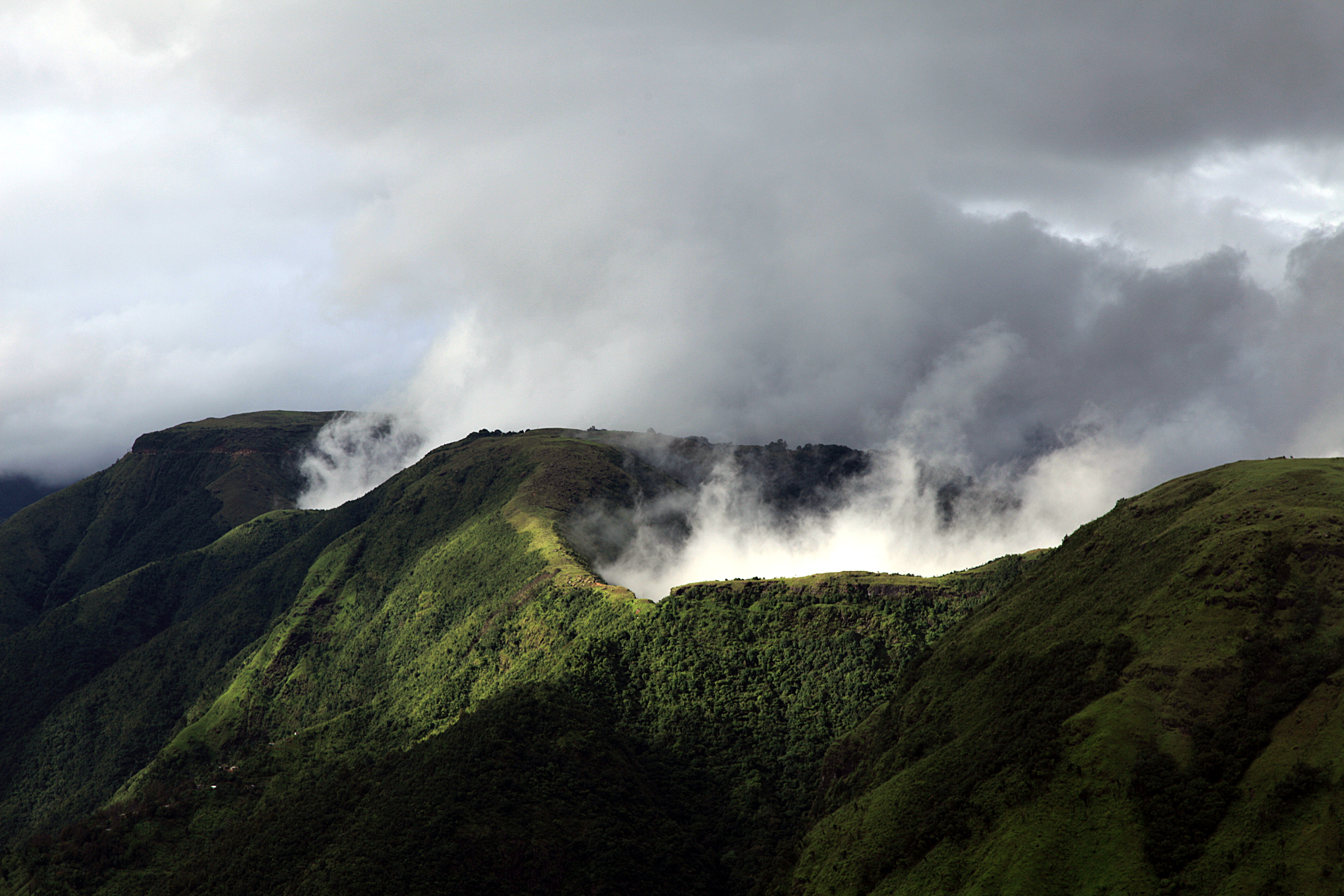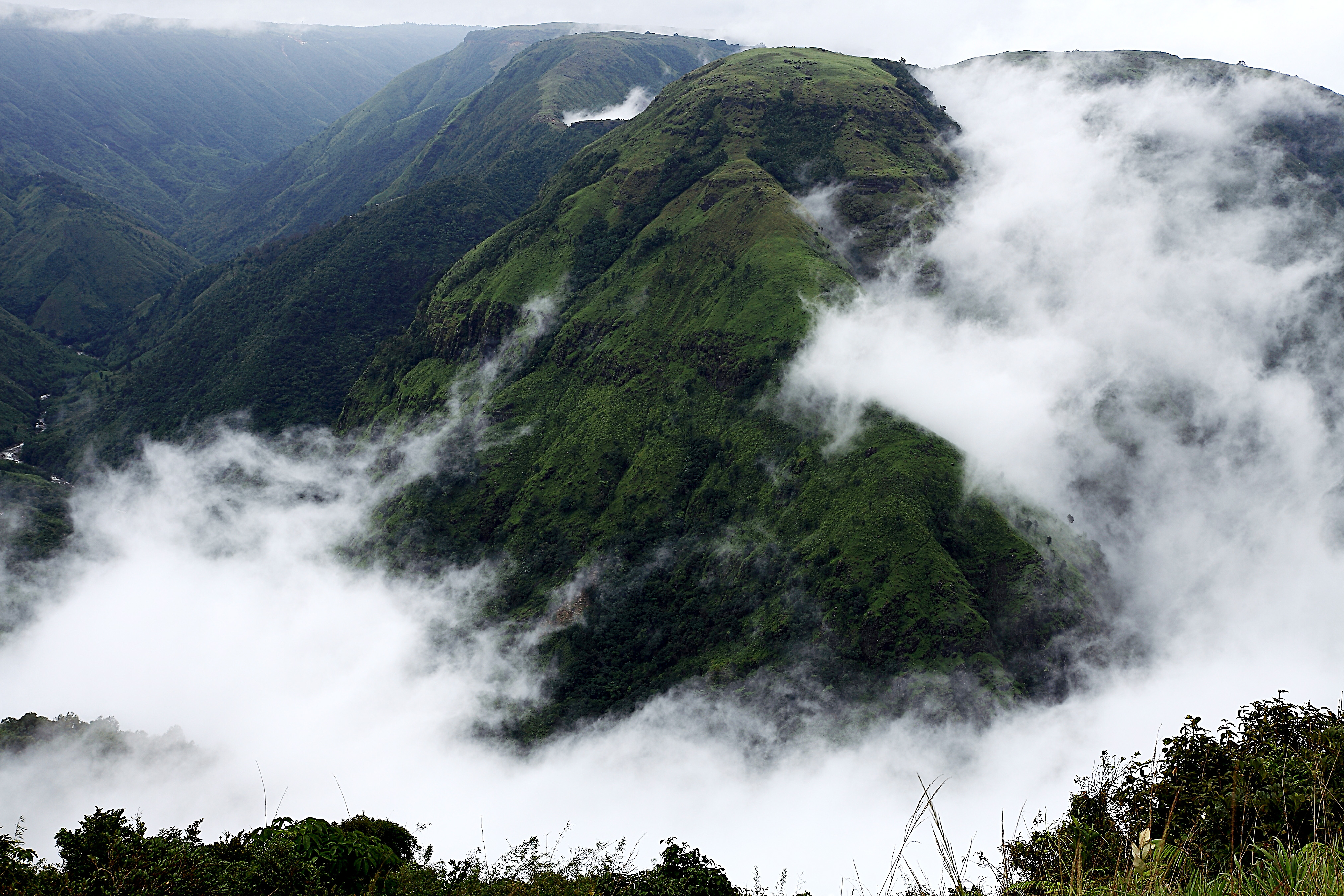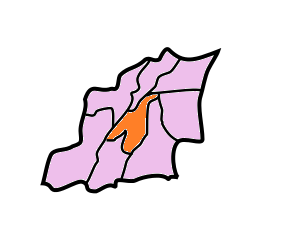|
Cherrapunji
Cherrapunji () - popularly known as, or Sohra - it's original native and official name, is a sub-divisional town (Proposed District) East Khasi Hills district in the Indian state of Meghalaya. It was the traditional capital of ''ka hima Sohra'' (Khasi tribal kingdom). Sohra has often been credited as being the wettest place on Earth, but currently, nearby Mawsynram holds that distinction. Sohra still holds the all-time record for the most rainfall in a calendar month and in a year, however. It received in July 1861 and between 1 August 1860 and 31 July 1861. Background Etymology The original native name for this town in Khasi language is ''Sohra'' (soh-ra), which was mispronounced "Cherra" by the 19th century British colonisers. Later, the suffix ''"punjee"'', a bengali term meaning "a cluster of villages", was added by people from the plains, and the name evolved into ''Cherrapunji'', meaning "land of oranges" in some interpretations, popularized by tourists from other ... [...More Info...] [...Related Items...] OR: [Wikipedia] [Google] [Baidu] |
Meghalaya
Meghalaya (; "the abode of clouds") is a states and union territories of India, state in northeast India. Its capital is Shillong. Meghalaya was formed on 21 January 1972 by carving out two districts from the Assam: the United Khasi Hills and Jaintia Hills and the Garo Hills.History of Meghalaya State Government of India The estimated population of Meghalaya in 2014 was 3,211,474. Meghalaya covers an area of approximately 22,429 square kilometres, with a length-to-breadth ratio of about 3:1.Meghalaya IBEF, India (2013) The state is bound to the south by the Bangladeshi divisions of Mymensingh Division, Mymensingh and Sylhet Division, Sylhet, to the west by the Bangladeshi ... [...More Info...] [...Related Items...] OR: [Wikipedia] [Google] [Baidu] |
Mawsynram
Mawsynram () is a town in the East Khasi Hills district of Meghalaya state in Northeastern India, 69 kilometres from Shillong, the state capital. Mawsynram receives the highest rainfall in India. It is reportedly the wettest place on Earth, with an average annual rainfall of . According to the ''Guinness Book of World Records'', Mawsynram received of rainfall in 1985. Mawsynram received 745.2 mm of rainfall on 19 August 2015, probably the highest rainfall received by the town in recent times. On 17 June 2022, Mawsynram set a new record by receiving 1003.6 mm in a span of 24 hours which has now become its highest single day record for the month of June and for its all-time single day record, beating its former record of 944.7 mm on 7 June 1966. Location Mawsynram is located at 25° 18′ N, 91° 35′ E, at an altitude of about 1,400 meters (4,600 ft), 15 km west of Cherrapunji, in the Khasi Hills in the state of Meghalaya (India). Climate and rain ... [...More Info...] [...Related Items...] OR: [Wikipedia] [Google] [Baidu] |
Meghalaya Subtropical Forests
The Meghalaya subtropical forests is an ecoregion of Northeast India. The ecoregion covers an area of , and despite its name, comprise not only the state of Meghalaya, but also parts of southern Assam, and a tiny bit of Nagaland around Dimapur and adjacent Bangladesh. It also contains many other habitats than subtropical forests, but the montane subtropical forests found in Meghalaya is an important biome, and was once much more widespread in the region, and for these reasons chosen as the most suitable name. The scientific designation is IM0126. The Meghalaya subtropical forests are part of the larger Indo-Burma biological hotspot with many endemic species not found anywhere else in the world. Together with the Western Ghats, Northeast India are the only two regions of India endowed with rainforest. For these and other reasons, protection and conservation of the Meghalaya subtropical forests are important on a local, national, regional and even global level. The ecoregion is ... [...More Info...] [...Related Items...] OR: [Wikipedia] [Google] [Baidu] |
East Khasi Hills District
East Khasi Hills is an administrative district in the state of Meghalaya in India. The district headquarters are located at Shillong. The district occupies an area of 2,748 km2 and has a population of 825,922 (as of 2011). , it is the most populous of Meghalaya's Districts of Meghalaya, 12 districts. History The former Khasi Hills district was divided into East and West Khasi Hills districts on 28 October 1976. On 4 June 1992, East Khasi Hills District was further divided into two administrative districts of East Khasi Hills District and Ri-Bhoi District. Geography Shillong is the district headquarters of East Khasi Hills District. East Khasi Hills District forms a central part of Meghalaya and covers a total geographical area of 2,748 km2. It lies approximately between 25°07" & 25°41" N Lat. And 91°21" & 92°09" E Long. The north of the district is bounded by the plain of Ri-Bhoi District gradually rising to the rolling grasslands of the Shillong Plateau inte ... [...More Info...] [...Related Items...] OR: [Wikipedia] [Google] [Baidu] |
Khasi Language
Khasi () is an Austroasiatic language with just over a million speakers in north-east India, primarily the Khasi people in the state of Meghalaya. It has associate official status in some districts of this state. The closest relatives of Khasi are the other languages in the Khasic group of the Shillong Plateau; these include Pnar, Lyngngam and War. Khasi is written using the Latin script. In the first half of the 19th century, attempts to write Khasi in Bengali-Assamese script met with little success. Etymology Geographic distribution and status Khasi is natively spoken by people in India (as of 2011). It is the first language of one-third of the population of Meghalaya, or , and its speakers are mostly found in the Khasi Hills and Jaintia Hills regions. There are also small Khasi-speaking communities in neighbouring states of India, the largest of which is in Assam: people. There is also a very small number of speakers in Bangladesh. Khasi has been an associate o ... [...More Info...] [...Related Items...] OR: [Wikipedia] [Google] [Baidu] |
Umshiang Double-Decker Root Bridge
Umshiang Double-Decker Root Bridge is a living root bridge in Meghalaya, India. It can be reached via trekking , or 6500 steps, from Cherrapunji. There is also a waterfall nearby. Due to tourism, the health of the root bridge has degraded. Meghalaya presented the root bridge at its 70th Republic Day (India), Republic Day ceremony. A replica of the bridge has been made in Nongriat in Cherrapunji to present the Khasi people, Khasi and Pnar people, Jaiñtia peoples' craft of building bridges from the secondary roots of trees. These living bridges are grown from a special type of rubber tree. As the roots grow, so the strength of the bridge increases. The root bridges are honoured as the Tajmahal of Meghalaya. They take around 25 years to grow and operate, but can carry the weight of 50 people and go on functioning for 500 years. See also * Breathing bridge References [...More Info...] [...Related Items...] OR: [Wikipedia] [Google] [Baidu] |
Khasi Hills
The Khasi Hills () are a low mountain formation on the Shillong Plateau in the Meghalaya state of India. The Khasi Hills are part of the Garo-Khasi-Jaintia range and connect with the Purvanchal Range and the larger Patkai Range further east. The Khasi Hills, and the whole Garo-Khasi-Jaintia range, are in the Meghalaya subtropical forests ecoregion. The Khasi Hills, and the entire Meghalaya state, was administratively part of Assam before 1970. In older sources in particular, the alternative transcription (linguistics), transcription Khasia Hills is seen. The region is inhabited mainly by tribal Khasi people, Khasi dwellers, who are traditionally in various chieftainships, states known as the Khasi Hill States. One of its capitals, Cherrapunji, Sohra, is considered one of the wettest places in the world. The majority of Khasis are Presbyterians followed by Catholics and Anglicans. The region came under the Khasi Hills district, which was divided into the West Khasi Hills and Eas ... [...More Info...] [...Related Items...] OR: [Wikipedia] [Google] [Baidu] |
Deforestation
Deforestation or forest clearance is the removal and destruction of a forest or stand of trees from land that is then converted to non-forest use. Deforestation can involve conversion of forest land to farms, ranches, or urban use. About 31% of Earth's land surface is covered by forests at present. This is one-third less than the forest cover before the expansion of agriculture, with half of that loss occurring in the last century. Between 15 million to 18 million hectares of forest, an area the size of Bangladesh, are destroyed every year. On average 2,400 trees are cut down each minute. Estimates vary widely as to the extent of deforestation in the tropics. In 2019, nearly a third of the overall tree cover loss, or 3.8 million hectares, occurred within humid tropical primary forests. These are areas of mature rainforest that are especially important for biodiversity and carbon storage. The direct cause of most deforestation is agriculture by far. More than ... [...More Info...] [...Related Items...] OR: [Wikipedia] [Google] [Baidu] |
Washout (erosion)
A washout is the sudden erosion of soft soil or other support surfaces by a gush of water, usually occurring during a heavy downpour of rain (a flash flood) or other stream flooding. These downpours may occur locally in a thunderstorm or over a large area, such as following the landfall of a tropical cyclone. If a washout occurs in a crater-like formation, it is called a sinkhole, and it usually involves a leaking or broken water main or sewerage pipes. Other types of sinkholes, such as collapsed caves, are not washouts. Widespread washouts can occur in mountainous areas after heavy rains, even in normally dry ravines. A severe washout can become a landslide, or cause a dam break in an earthen dam. Like other forms of erosion, most washouts can be prevented by vegetation whose roots hold the soil and/or slow the flow of surface and underground water. Deforestation increases the risk of washouts. Retaining walls and culverts may be used to try to prevent washouts, although p ... [...More Info...] [...Related Items...] OR: [Wikipedia] [Google] [Baidu] |
Xerophytic
A xerophyte () is a species of plant that has adaptations to survive in an environment with little liquid water. Examples of xerophytes include cactus, cacti, pineapple and some gymnosperm plants. The morphology (biology), morphology and physiology of xerophytes are adapted to conserve water during dry periods. Some species called resurrection plants can survive long periods of extreme dryness or desiccation of their Tissue (biology)#Plant tissue, tissues, during which their metabolism, metabolic activity may effectively shut down. Plants with such morphological and physiological adaptations are said to be .” Xeromorphic”, The Cambridge Illustrated Glossary of Botanical Terms, Michael Hickey, Clive King, Cambridge University Press, 2001 Xerophytes such as cacti are capable of withstanding extended periods of dry conditions as they have deep-spreading roots and capacity to store water. Their waxy, thorny leaves prevent loss of moisture. Introduction Plants absorb water from the ... [...More Info...] [...Related Items...] OR: [Wikipedia] [Google] [Baidu] |
Ecosystem
An ecosystem (or ecological system) is a system formed by Organism, organisms in interaction with their Biophysical environment, environment. The Biotic material, biotic and abiotic components are linked together through nutrient cycles and energy flows. Ecosystems are controlled by external and internal Environmental factor, factors. External factors—including climate—control the ecosystem's structure, but are not influenced by it. By contrast, internal factors control and are controlled by ecosystem processes; these include decomposition, the types of species present, root competition, shading, disturbance, and succession. While external factors generally determine which Resource (biology), resource inputs an ecosystem has, their availability within the ecosystem is controlled by internal factors. Ecosystems are wikt:dynamic, dynamic, subject to periodic disturbances and always in the process of recovering from past disturbances. The tendency of an ecosystem to remain clo ... [...More Info...] [...Related Items...] OR: [Wikipedia] [Google] [Baidu] |
India
India, officially the Republic of India, is a country in South Asia. It is the List of countries and dependencies by area, seventh-largest country by area; the List of countries by population (United Nations), most populous country since 2023; and, since its independence in 1947, the world's most populous democracy. Bounded by the Indian Ocean on the south, the Arabian Sea on the southwest, and the Bay of Bengal on the southeast, it shares land borders with Pakistan to the west; China, Nepal, and Bhutan to the north; and Bangladesh and Myanmar to the east. In the Indian Ocean, India is near Sri Lanka and the Maldives; its Andaman and Nicobar Islands share a maritime border with Thailand, Myanmar, and Indonesia. Modern humans arrived on the Indian subcontinent from Africa no later than 55,000 years ago., "Y-Chromosome and Mt-DNA data support the colonization of South Asia by modern humans originating in Africa. ... Coalescence dates for most non-European populations averag ... [...More Info...] [...Related Items...] OR: [Wikipedia] [Google] [Baidu] |







